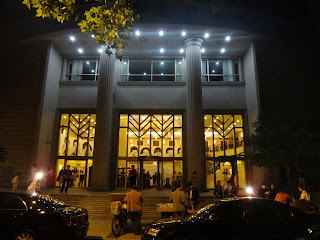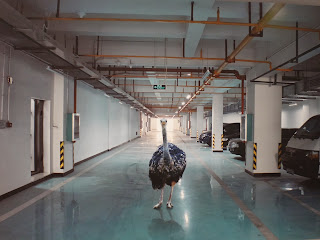As I leave for Beijing, these are my Shanghai impressions:
Shopping District - Old Shanghai
SPAF central square - video art piece on a building
Shanghai Dramatic Arts Centre
Old Palace, Shanghai
1) This was my first trip to Asia. I was excited, nervous, and, as Nicola Barker might say, wide open.
2) I spent 6 days at an international theatre festival and conference. I saw work, met people, and listened to many speeches.
Wendy - the helpful helper at China SPAF
3) The people I met were mostly foreign artistic directors from across the globe, producers, and agents. I bonded with some terrific Aussies (from Sydney Theatre Co., Melbourne Theatre Co., the OzAsia Festival, Critical Stages, and a children's theatre co. - an entire cohort of mischievous merrymakers). Sadly, I met almost no Chinese artists. The festival hasn't yet figured out an effective mechanism for the foreigners to be able to meet the Chinese in a social context.
Virginia Lovett, ED, Melbourne Theatre Co. and Rachel Azzopardi, Programming Director, Sydney Theatre Co.
4) An awareness dawned on me that the predominant language of the Chinese presenters was a marketing / economic language. Gradually, I realized that several of the speeches - from some Westerners, some other non-Chinese Asians, and from some respected Chinese scholars - were trying to counteract the trend to see the arts as a commodity. It's a road many countries have gone down in an attempt to gain influence or support or status, and it's fraught with trouble. Art is much more to a society than a widget. Policy makers and cultural practitioners must remain vigilant about placing our collective imagination on the level of an assembly line. The rules aren't the same.
"Growth" and "Development" talk at SPAF
5) I saw a spectrum of shows. The ticketing at the festival was chaotic and disorganized, so I was often disappointed to not get into shows I wanted to see, and was similarly disappointed by shows I did see. The quality varied enormously. My favourite stuff was on my last day, when we made a tour to two traditional opera companies, and saw excerpts of their work. One Peking Opera company did selections from an adaptation of Hamlet.
It was riveting: acrobatic, sung, spoken and highly stylized, with an astonishing level of training in the performers. From there, we visited another opera company who performed not in Mandarin, but in a local Shanghai dialect. Here we saw jaw-dropping martial arts / acrobatic feats from two traditional stories, performed by their apprentice performers (ranging in age from 16 to 18). Here were fully multi-disciplinary forms with a long history of virtuosity. From there, we saw a more contemporary mask / dance telling of a story about an old woman who goes blind, and her fisherman husband who cares for her - also wonderful.
Hamlet and Polonius - Peking Opera Style
Hamlet and Poor Yorick
Gertrude and Caludius
It was riveting: acrobatic, sung, spoken and highly stylized, with an astonishing level of training in the performers. From there, we visited another opera company who performed not in Mandarin, but in a local Shanghai dialect. Here we saw jaw-dropping martial arts / acrobatic feats from two traditional stories, performed by their apprentice performers (ranging in age from 16 to 18). Here were fully multi-disciplinary forms with a long history of virtuosity. From there, we saw a more contemporary mask / dance telling of a story about an old woman who goes blind, and her fisherman husband who cares for her - also wonderful.
6) On the final day, I was part of an informal conversation with one of the festival organizers. It was an epiphany. He spoke of the RAW (Rising Artists Works) program - what a fight it is to keep it (a fight with the government, that is), and how proud he was of these young artists taking big risks to make contemporary work. He had tears in his eyes as he spoke. Here was a man who loved his country, and wanted the next generation to be able to adapt to emerging forms, to find ways to reinvigorate the ancient forms (like Peking Opera) that the young are becoming less and less interested in. The RAW work I saw was terrible - amazing skills, some strong ideas, but no matching ability to realise these ideas in a rigorous way on stage - no good direction, no good dramaturgy. But to this organizer, he was seeing the future, and it made him proud. Context is everything.
7) The day after the festival, I walked through the streets of Shanghai. I visited a contemporary gallery complex (M50) and saw some wonderful - and political - contemporary visual art. In this, China is a leader. I met a Belgian visual artist who has been living in Shanghai for 8 years. He spoke of the giant increase in rents in the last two years, and how the city may not be affordable for much longer. For now, though, it's still a better place to make work than Europe - materials (canvas, light boxes, etc) are higher quality, arrive more quickly and are much cheaper than in Belgium.
Art on display at M50 - photo manipulation with ostrich
Art on display at M50 - photo manipulation with monkey
Art on display at M50 - pollution, China style
Art on display at M50 - photo
Art on display at M50 - this was one of a several huge portraits of marginalised poets in China
These poets barely mange to survive, and are ignored by the state - this exhibit was to give them some exposure
The artist statement is a withering and quite political indictment of Chinese arts policy
M50 - a still from a video art piece where a woman's hands carress ice hands until nothing of the latter is left
A painting at an M50 gallery
My final impression of Shanghai was of acceleration. Money is being poured into this city. Its status as an International City is being actively promoted and backed up with billions by the government. The struggle is building a cultural policy inside this headlong rush that is grounded in something real and true and built by artists rather than by government. Still, as I traveled in the immaculate subway to the enormous gleaming train station to board the high speed bullet train to Beijing among the throngs of polite people and responsive and responsible workers - I was deeply impressed.
This is the future.




















No comments:
Post a Comment